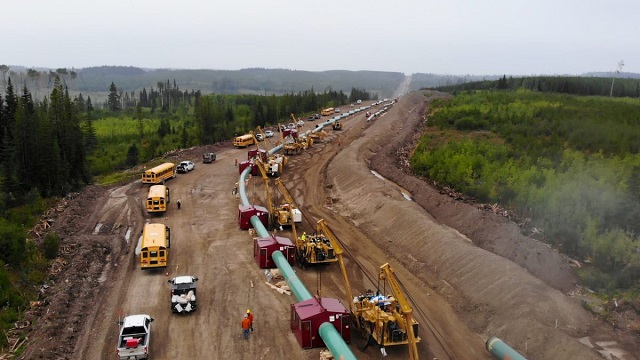Alberta
Province planning “Heroes Fund” to help families of first responders who die on duty

From the Province of Alberta
Supporting Alberta’s heroes and their families
Creating the Alberta’s Heroes Fund will improve benefits for the families of fallen first responders and recognize their noble service.
Bill 47, Ensuring Safety and Cutting Red Tape, will allow Alberta’s government to follow through on its commitment to create the Heroes Fund. Alberta’s government will honour the sacrifices of first responders who die as a result of performing their duties. The Heroes Fund will provide a one-time tax-free payment of $100,000 to eligible families through the Workers’ Compensation Board.
“There is no higher form of public service than to risk one’s life to maintain public safety. While nothing can replace a loved one, the Heroes Fund will provide families with extra support and improved benefits while honouring the brave and valiant service of Alberta’s fallen heroes.”
“First responders commit their lives to serving their communities and we must honour their heroic work and ensure their loved ones have the support they need. Our government committed to ensuring families of Alberta’s fallen heroes are supported, and while I wish this fund wasn’t needed, today we are delivering on our promise to honour them and the sacrifices they’ve made.”
Eligible first responders include firefighters, police officers, paramedics, sheriffs and provincial corrections officers. Alberta’s Workers’ Compensation Board (WCB) will administer the Heroes Fund and will begin identifying eligible families and administering payments, which are retroactive to April 1, 2020.
“Day in and day out, our members put their health and safety on the line to help Albertans often during the most difficult times in their lives. First responders understand that this is our calling, this is what we do. We acknowledge the inherent risk of our profession and do what we can to mitigate risk. Unfortunately, risk cannot always be mitigated, and every year we see firefighters, paramedics and dispatchers who are killed from job-related injuries, occupational disease, or mental health struggles. The Alberta Fire Fighters Association would like to take this opportunity to applaud the Government of Alberta for the Heroes Fund. While this fund will never replace the void from the loss of a loved one, it will help ease the inevitable financial hardships caused by those who have paid the ultimate sacrifice.”
“First responders are charged with the significant responsibility of upholding safety in our communities and protecting citizens, often placing their lives in danger. Losing a loved one in the line of duty is a tragedy many of us are lucky to be unfamiliar with, but for those who must live with that grief and its many hardships, this fund provides much-needed support and commemoration of heroes that made the ultimate sacrifice.”
“As a former sergeant with the Calgary Police Service, I was honoured to serve with many brave police officers, firefighters, and paramedics in the City of Calgary. I know first-hand how our first responders put their lives on the line every day in the service of Albertans and I am proud that our government is fulfilling our commitment to create a Heroes Fund. Our government is taking concrete action to give the families of our fallen heroes the help they need in difficult times.”
“I’m proud to be part of a government that delivers on its promises and stands up for first responders and their families. As a former paramedic firefighter, I understand the sacrifices first responders make to serve their communities and answer the call to service. I wish everyone could return home safely at the end of the day, but for those who pay the ultimate price serving their communities, the creation of this fund will make a difference in the lives of family members when they need it most. Establishing this fund will make Alberta the only province with a program of this type to honour and pay tribute to the families of first responders.”
Quick facts
- Budget 2020 commits $1.5 million per year for the Heroes Fund for three years, starting in the 2020-21 fiscal year.
- Alberta is the only province with a program of this type for families of fallen first responders.
- Heroes Fund payments are separate from regular workers’ compensation fatality benefits.
- The Heroes Fund will take effect when Bill 47 receives royal assent.
- There were 106 Alberta first responder fatalities between 2010 and 2019.
- 90 per cent of these were firefighters due to occupational illness.
- Albertans are served by:
- More than 14,000 full-time, part-time, casual and volunteer firefighters. About 80 per cent are volunteers.
- More than 7,500 police officers.
- More than 9,400 paramedics.
Alberta
Alberta bill would protect freedom of expression for doctors, nurses, other professionals

From LifeSiteNews
‘Peterson’s law,’ named for Canadian psychologist Jordan Peterson, was introduced by Alberta Premier Danielle Smith.
Alberta’s Conservative government introduced a new law that will set “clear expectations” for professional regulatory bodies to respect freedom of speech on social media and online for doctors, nurses, engineers, and other professionals.
The new law, named “Peterson’s law” after Canadian psychologist Jordan Peterson, who was canceled by his regulatory body, was introduced Thursday by Alberta Premier Danielle Smith.
“Professionals should never fear losing their license or career because of a social media post, an interview, or a personal opinion expressed on their own time,” Smith said in a press release sent to media and LifeSiteNews.
“Alberta’s government is restoring fairness and neutrality so regulators focus on competence and ethics, not policing beliefs. Every Albertan has the right to speak freely without ideological enforcement or intimidation, and this legislation makes that protection real.”
The law, known as Bill 13, the Regulated Professions Neutrality Act, will “set clear expectations for professional regulatory bodies to ensure professionals’ right to free expression is protected.”
According to the government, the new law will “Limit professional regulatory bodies from disciplining professionals for expressive off-duty conduct, except in specific circumstances such as threats of physical violence or a criminal conviction.”
It will also restrict mandatory training “unrelated to competence or ethics, such as diversity, equity, and inclusion training.”
Bill 13, once it becomes law, which is all but guaranteed as Smith’s United Conservative Party (UCP) holds a majority, will also “create principles of neutrality that prohibit professional regulatory bodies from assigning value, blame or different treatment to individuals based on personally held views or political beliefs.”
As reported by LifeSiteNews, Peterson has been embattled with the College of Psychologists of Ontario (CPO) after it mandated he undergo social media “training” to keep his license following posts he made on X, formerly Twitter, criticizing Trudeau and LGBT activists.
He recently noted how the CPO offered him a deal to “be bought,” in which the legal fees owed to them after losing his court challenge could be waived but only if he agreed to quit his job as a psychologist.
Early this year, LifeSiteNews reported that the CPO had selected Peterson’s “re-education coach” for having publicly opposed the LGBT agenda.
The Alberta government directly referenced Peterson’s (who is from Alberta originally) plight with the CPO, noting “the disciplinary proceedings against Dr. Jordan Peterson by the College of Psychologists of Ontario, demonstrate how regulatory bodies can extend their reach into personal expression rather than professional competence.”
“Similar cases involving nurses, engineers and other professionals revealed a growing pattern: individuals facing investigations, penalties or compulsory ideological training for off-duty expressive conduct. These incidents became a catalyst, confirming the need for clear legislative boundaries that protect free expression while preserving professional standards.”
Alberta Minister of Justice and Attorney General Mickey Amery said regarding Bill 13 that the new law makes that protection of professionals “real and holds professional regulatory bodies to a clear standard.”
Last year, Peterson formally announced his departure from Canada in favor of moving to the United States, saying his birth nation has become a “totalitarian hell hole.”
Alberta
‘Weird and wonderful’ wells are boosting oil production in Alberta and Saskatchewan

From the Canadian Energy Centre
Multilateral designs lift more energy with a smaller environmental footprint
A “weird and wonderful” drilling innovation in Alberta is helping producers tap more oil and gas at lower cost and with less environmental impact.
With names like fishbone, fan, comb-over and stingray, “multilateral” wells turn a single wellbore from the surface into multiple horizontal legs underground.
“They do look spectacular, and they are making quite a bit of money for small companies, so there’s a lot of interest from investors,” said Calin Dragoie, vice-president of geoscience with Calgary-based Chinook Consulting Services.
Dragoie, who has extensively studied the use of multilateral wells, said the technology takes horizontal drilling — which itself revolutionized oil and gas production — to the next level.
“It’s something that was not invented in Canada, but was perfected here. And it’s something that I think in the next few years will be exported as a technology to other parts of the world,” he said.
Dragoie’s research found that in 2015 less than 10 per cent of metres drilled in Western Canada came from multilateral wells. By last year, that share had climbed to nearly 60 per cent.
Royalty incentives in Alberta have accelerated the trend, and Saskatchewan has introduced similar policy.
Multilaterals first emerged alongside horizontal drilling in the late 1990s and early 2000s, Dragoie said. But today’s multilaterals are longer, more complex and more productive.
The main play is in Alberta’s Marten Hills region, where producers are using multilaterals to produce shallow heavy oil.
Today’s average multilateral has about 7.5 horizontal legs from a single surface location, up from four or six just a few years ago, Dragoie said.
One record-setting well in Alberta drilled by Tamarack Valley Energy in 2023 features 11 legs stretching two miles each, for a total subsurface reach of 33 kilometres — the longest well in Canada.
By accessing large volumes of oil and gas from a single surface pad, multilaterals reduce land impact by a factor of five to ten compared to conventional wells, he said.
The designs save money by skipping casing strings and cement in each leg, and production is amplified as a result of increased reservoir contact.
Here are examples of multilateral well design. Images courtesy Chinook Consulting Services.
Parallel
Fishbone
Fan
Waffle
Stingray
Frankenwells
-

 Health18 hours ago
Health18 hours agoTens of thousands are dying on waiting lists following decades of media reluctance to debate healthcare
-

 Business2 days ago
Business2 days agoI Was Hired To Root Out Bias At NIH. The Nation’s Health Research Agency Is Still Sick
-

 Carbon Tax22 hours ago
Carbon Tax22 hours agoCarney fails to undo Trudeau’s devastating energy policies
-

 Opinion13 hours ago
Opinion13 hours agoLandmark 2025 Study Says Near-Death Experiences Can’t Be Explained Away
-

 Business19 hours ago
Business19 hours agoBudget 2025: Ottawa Fakes a Pivot and Still Spends Like Trudeau
-

 International1 day ago
International1 day agoCanada’s lost decade in foreign policy
-

 armed forces1 day ago
armed forces1 day agoCanada At Risk Of Losing Control Of Its Northern Territories
-

 Business2 days ago
Business2 days agoLarge-scale energy investments remain a pipe dream











